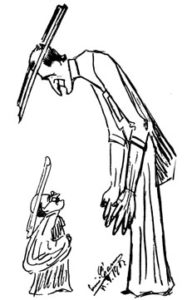The basic categories of the singing voice, soprano, alto, tenor and bass with their intermediate categories of mezzo-soprano and baritone are the basis of the vocal ranges in the German Fach system. In practice, the voices types are further defined according to quality, range, volume, acting demands, and physical appearance. The first division separates each voice type into two major groups: 1. the Seriösefächer (serious categories), and 2. the Spiel- and Charakterfächer (acting and character categories).
Voices that belong to the Seriösefächer demand, above all, vocal quality; that is to say, noble vocal material and perfect line. The Seriösefächer is further divided into three groups. The first group contains the lyric voices. This does not refer to size as much as the ability to sing a beautiful, lyric line–a Mimi as opposed to Mussetta. The second group is the so-called Zwischenfach that contains voice types possessing qualities of both the lyric and dramatic voice. Zwischenfach singers have the ability to spin a beautiful line as well as deliver dramatic passages without strain. In the Italian school, this voice is often referred to as a Spinto. The third group contains the Hochdramatic voices and is reserved primarily for those who sing the works of Richard Wagner.

Of course, the Spiel- and Charakterfächer also demand excellent vocal quality. As the name implies (Spiel from spielen = to act), the Spielfach requires a high degree of acting ability, ease of movement, and a sense of comedy. Voices belonging to the Charakterfach place emphasis on role portrayal and emotional and intellectual presentation. In regards to vocal size, the Spielfach generally contains the lighter voices and the Charakterfach the heavier voices.
The biggest confusion with the Fach system comes with the Zwischenfach category.  Often a young singer whose voice hasn’t found its proper color or range will sing roles from widely different Fächer. Despina and Mimi. Rather than allowing a singer to perform repertoire from two separate voice categories, the term Zwischenfach refers to specific voice types that lie between the lyric and dramatic Fächer whose roles contain both lyric and dramatic singing.
Often a young singer whose voice hasn’t found its proper color or range will sing roles from widely different Fächer. Despina and Mimi. Rather than allowing a singer to perform repertoire from two separate voice categories, the term Zwischenfach refers to specific voice types that lie between the lyric and dramatic Fächer whose roles contain both lyric and dramatic singing.
It is best to try to find the right Fach for you. Search for a single category those roles you can easily perform. All the roles will not necessarily be your “best” roles but none should present such difficulties that they may do harm to your voice. If you find that nothing quite fits, this is may an indication that your voice is not yet ready for the demands of a full-time opera position in a repertoire theater and it is better to wait until it is clear in which direction the voice is going before trying for an engagement.
In the following articles in this series, we will look closely at the specific categories for each voice and offer list of roles and aria that are appropriate for each voice type.
(This article is the second part in the series on the German Fach System and is based on information derived from Rudolf Kloiber’s “Handbuch der Oper”, 9th edition, Deutschen Taschenbuch Verlag. Read the first part of this series here.)
